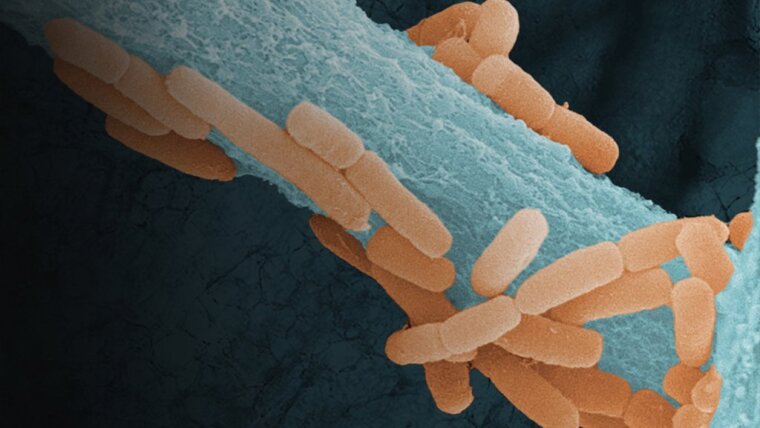
- Life
- Research
Published: | By: Maria Schulz
An invisible intruder puts the delicate balance in our lungs to the test: the mold Aspergillus fumigatus, harmless in nature, can become a serious danger if the immune system is weakened - and change the entire bacterial world in the lungs. But that's not all: the intestines and metabolism also appear to be affected by a lung infection.
A fungus that does more than expected
Aspergillus fumigatus can be found almost everywhere—in soil, compost or in the air. It is usually harmless for healthy people. However, in patients with a weakened immune system, it can cause severe lung infection, known as invasive aspergillosis. The fungus may potentially alter the oxygen levels in the lungs to a degree that it creates a more suitable environment for certain bacteria—such as Ligilactobacillus murinus, typically found in the intestines, oral cavity and lungs of mice—to better survive and potentially thrive. This interaction could possibly influence disease progression and enable new treatment strategies.
From the lungs to the gut—everything is connected
It has long been known that the gut and lungs are closely connected. New data from a research team in Jena has now deepened this understanding. The researchers found evidence that not only the lung microbiome, but also the gut microbiome and certain metabolic products in the blood change during infection of the lungs with Aspergillus fumigatus. This so-called “gut-lung axis” could play an important role in future therapy. The work was carried out by scientists from the Cluster of Excellence Balance of the MicroverseExternal link, the Leibniz Institute for Natural Product Research and Infection Biology—Hans Knöll Institute (Leibniz-HKI) and the Friedrich Schiller University Jena and was recently published in the journal Cell Reports.
Methodology and key findings
The research team used a mouse model for invasive aspergillosis. To find out how the infection affects the microbes in the lungs and intestines, the researchers examined the genetic markers of the microorganisms. To simulate the clinical conditions as realistically as possible, the effects of immunosuppression and antifungal treatment with voriconazole were also considered.
The team used specialized methods, including DNA sequencing to identify bacteria in the lungs and intestines, and quantitative PCR to measure the amount of the fungal pathogen Aspergillus fumigatus and the dominant bacterium Ligilactobacillus murinus in the lungs. In addition, metabolomic analyses of plasma and lung tissue were carried out. These analyses record and quantify all metabolic products in a biological system in order to understand changes in the metabolism. In addition, the researchers isolated live bacteria from the lower airways of the mice and co-cultured them with Aspergillus fumigatus to investigate possible interactions.
A key finding of the study was, that the fungal infection unbalances both the lung and gut microbiome. In the lungs, this leads to an accumulation of anaerobic bacteria. Particularly striking was the increased growth of Ligilactobacillus murinus, suggesting that the fungus creates a microaerophilic niche (low oxygen concentrations) that favors this bacterium.
Limitations of the study—what is not (yet) answered
Analyzing the lung microbiome is challenging because the amount of bacterial DNA in the lung is very low and overlaid by human DNA. “Although we analyzed numerous control samples, the results might still include some misclassifications when it comes to bacteria present at extremely low abundances,” says Liubov Nikitashina, first author of the study. The low DNA yield also mostly limited bacterial identification to the genus level. Improved methods for bacterial DNA extraction from such poorly colonized body sites could make future studies even more meaningful.
The study raises important questions for future research: What role do anaerobic bacteria such as Ligilactobacillus murinus play in modulating Aspergillus fumigatus infections? Could the accumulation of these bacteria in the lungs serve as a diagnostic marker or even enable new therapeutic approaches?
A small fungus with a big effect
Fungal infections are a serious problem, especially for immunocompromised people or those who are already seriously ill—for example in intensive care units or with cancer. The new findings provide important information on how such infections can be better understood and possibly prevented. In future, it may be possible to specifically influence the microbiome in order to support the body in its fight against the fungus—or to develop new drugs that target precisely this area.
The work on this project was funded by the German Research Foundation, the Federal Ministry of Education and Research and the European Union.
Original publication:
Nikitashina L, Chen X, Radosa L, Li K, Straßburger M, Seelbinder B, Böhnke W, Vielreicher S, Nietzsche S, Heinekamp T, Jacobsen ID, Panagiotou G, Brakhage AA (2025) The murine lung microbiome is disbalanced by the human-pathogenic fungus Aspergillus fumigatus resulting in enrichment of anaerobic bacteria, Cell Reports 44 DOI: https://doi.org/10.1016/j.celrep.2025.115442External link
Contact:

Beutenbergstraße 11a
07745 Jena Google Maps site planExternal link